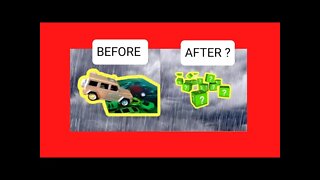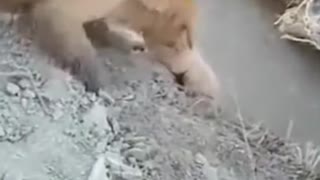Rain is liquid precipitation: water falling from the sky.
Rain is liquid precipitation: water falling from the sky. Raindrops fall to Earth when clouds become saturated, or filled, with water droplets. Millions of water droplets bump into each other as they gather in a cloud. When a small water droplet bumps into a bigger one, it condenses, or combines, with the larger one. As this continues to happen, the droplet gets heavier and heavier. When the water droplet becomes too heavy to continue floating around in the cloud, it falls to the ground.
Human life depends on rain. Rain is the source of freshwater for many cultures where rivers, lakes, or aquifers are not easily accessible. Rain makes modern life possible by providing water for agriculture, industry, hygiene, and electrical energy. Governments, groups, and individuals collect rain for personal and public use.
Raindrops condense around microscopic pieces of material called cloud condensation nuclei (CCN). CCN can be particles of dust, salt, smoke, or pollution. Brightly colored CCN, such as red dust or green algae, can cause colored rain. Because CCN are so tiny, however, color is rarely visible.
When rain forms around certain types of pollutants, such as sulfur dioxide and nitrogen oxide, the CCN react with water to make the rain acidic. This is called acid rain. Acid can harm plants, aquatic animals like fish and frogs, and the soil. Sulfur dioxide and nitrogen oxide can be released into the atmosphere naturally, such as through a volcanic eruption. These pollutants can also be released by human activity, such as the burning of fossil fuels.
Burning fossil fuels can influence rain patterns. In urban areas, where many vehicles are on the road at once, rainfall is more likely during the weekend than during the week. This is because during the week, millions of cars release exhaust into the atmosphere, creating billions of CCN in the clouds. By the end of the week, clouds are much more likely to be saturated with moisture and CCN.
Scientists have developed a process called cloud seeding to "plant" CCNs in clouds to cause rain. Cloud seeding would reduce drought, although there is very little evidence that it works yet.
Although most people think raindrops look like teardrops, they actually look more like chocolate chip cookies. Like raw balls of dough dropped on a cookie sheet, the smallest raindrops, up to 1 millimeter in diameter, are actually spherical. At 2 millimeters raindrops start to flatten, because of the air pressure pushing up on them as they fall to Earth. This effect is increased at 3 millimeters, and depressions form on the bottom of the drops as the air pushes up on the drops harder. At 4 millimeters raindrops actually distort into a shape that looks like a parachute. When they get to be about 4.5 millimeters in diameter, raindrops are so big that they break apart into two or more separate drops.
Raindrops measure 0.5 millimeter (.02 inches) in diameter or larger. Drizzle, which is smaller than rain, consists of drops smaller than 0.5 millimeter. Most of Earth's precipitation falls as rain.
Raindrops often begin as snowflakes, but melt as they fall through the atmosphere. Snow forms in the same way rain does, but in colder conditions.
Rain falls at different rates in different parts of the world. Dry desert regions can get less than a centimeter (0.4 inches) of rain every year, while tropical rain forests receive more than a meter (3.2 feet). The world record for the most rain in a single year was recorded in Cherrapunji, India, in 1861, when 2,296 centimeters (905 inches) of rain fell.
-
 4:03
4:03
SHORTSPODCAST13
2 years agoFALLING CARS FALLING INTO GREEN WATER TO THE SOUND OF RAIN
2 -
 0:13
0:13
Kumneger
2 years agoGolden Retriever Puppy Saved From Falling in Water
25 -
 2:06
2:06
KTNV
2 years agoNo explanation for 'mystery liquid' falling from sky over neighborhood
1183 -
 2:57:13
2:57:13
SNEAKO
15 hours ago"Who Do You Hate the Most?" - One Minute Podcast
112K118 -
 4:47:25
4:47:25
SonnyFaz
10 hours agoDr. Shiva x Sonny IRL
63.9K22 -
 4:28:03
4:28:03
LumpyPotatoX2
17 hours agoSub-Sunday on Rumble - #RumbleTakeover
72.8K4 -
 26:04
26:04
iamLucid
1 day agoVideo Game Piracy is Unstoppable
97.3K47 -
 16:31
16:31
GeekyNerdyTechy
2 days agoZHIYUN Fiveray M20C Combo Light Review & Tutorial
114K8 -
 8:29
8:29
ParisDemers
1 day agoThe Kratos/God Of War Workout Program (His Real-Life Training)
102K8 -
 16:14
16:14
CarlCrusher
1 day agoSkinwalker's Evil Twin - Beyond Skinwalker Ranch Behind the Scenes Season 1 ep 2
102K12